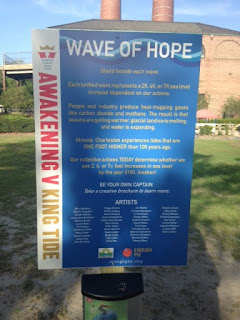 |
| Enough Pie’s Wave of Hope installation in front of St. Julian Devine Community Center. |
Want to
know whether you need to pack the car or the johnboat to travel to campus?
American College of the Building Arts professor Christina Butler advises you to
take a look at this map and if any of the streets on your
route had a former life as a tidal creek, then bring a paddle.
Speaking
at Enough Pie’s "Awakening V: King Tide," Butler told an audience at the Cigar Factory on Thursday, May 11, 2017 that
Charleston’s flooding woes are due just as much to early colonial building
practices as they are to current climate change. And in spite of all of the
repairs and new drainage projects, things will only get worse.
 The
problem? Eighteenth-century settlers found very little desirable real-estate on
the peninsula, so they quickly set out to make their own. Anything that could
not be repurposed was tossed into creeks and marshland. That meant that streets
and building sites were created atop animal carcasses, vegetable material,
human and construction waste, and even the corpses of British and Hessian
soldiers! All of the land east of East Bay Street and north of Market Street
rests on this great garbage dump, including the Hampstead area where Palmer now
stands. Needless to say, in those days, ships arriving to the city could smell
it before they could see it.
The
problem? Eighteenth-century settlers found very little desirable real-estate on
the peninsula, so they quickly set out to make their own. Anything that could
not be repurposed was tossed into creeks and marshland. That meant that streets
and building sites were created atop animal carcasses, vegetable material,
human and construction waste, and even the corpses of British and Hessian
soldiers! All of the land east of East Bay Street and north of Market Street
rests on this great garbage dump, including the Hampstead area where Palmer now
stands. Needless to say, in those days, ships arriving to the city could smell
it before they could see it.
And who
was responsible for hauling and spreading the debris? Butler says that enslaved
West Africans did much of the work. This onerous task was ongoing, as each tide
pulled the fill into the harbor--so much so, that dumping regulations were soon
put into place so that shipping lanes would not be blocked.
West
African sweat and labor built much of the land in Charleston, and West African
ingenuity was used to keep it in place. Early drainage engineering first
employed on the peninsula was based on the trunk systems used in rice
cultivation, and by the 1850s, brick and mortar versions were buried beneath
the city streets. In fact, we are still depending upon those nineteenth-century
tunnels to keep our feet dry.
Unfortunately,
those tunnels and the more recent pump projects are still resting on an
unstable 300-year-old garbage dump. Add to that, the booming construction
business on the peninsula and the rising global tides might make us all wish we
were sporting gills.

No comments:
Post a Comment
Note: Only a member of this blog may post a comment.